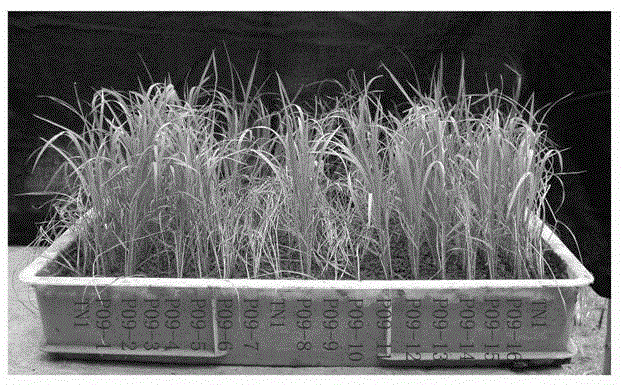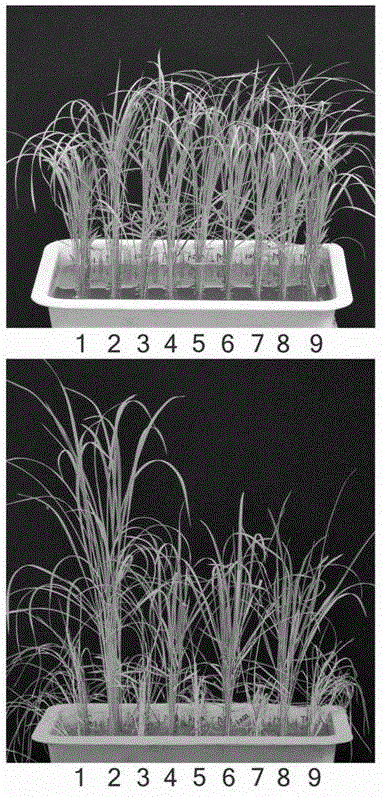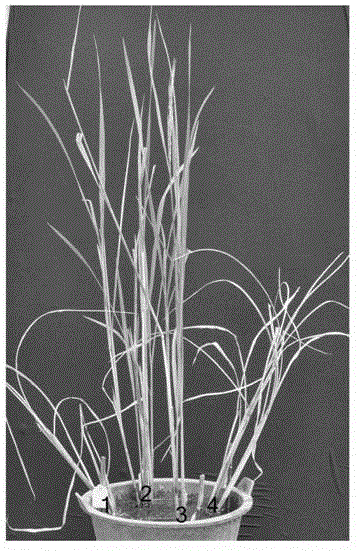Rice brown planthopper resistance gene bph9 and its molecular markers and applications
A technology of anti-BPH and molecular markers, applied in application, genetic engineering, plant gene improvement, etc., can solve problems such as difficult operation, increased production cost, and non-target biological poisoning
- Summary
- Abstract
- Description
- Claims
- Application Information
AI Technical Summary
Problems solved by technology
Method used
Image
Examples
Embodiment 1
[0162] Example 1 Positional cloning of Bph9 gene and development of linked molecular markers
[0163] 1. Preliminary positioning results of Bph9
[0164] Bph9-containing F 2 Populations, 93-11 and Pokkali (IRGC 108921) were all from the National Crop Germplasm Conservation Center of the Institute of Crop Science, Chinese Academy of Agricultural Sciences, and used the CTAB method (Murray MG&Thompson, 1980 Rapid isolation of high-molecular-weight plant DNA.Nucleic Acids Res 8 :4321-4325) to extract parent and F 2 Genomic DNA of each individual plant in the population. each F 2 A single plant obtains the corresponding F 2:3 family lineage. To identify F 2 To locate the N. lugens resistance phenotype of each individual plant in the population, the seedling group method was used to investigate the resistance performance of each individual plant of the F2:3 family (see figure 1 ) to F 2:3 Family resistance level represents F 2 BPH-resistant phenotype of individual plants. ...
Embodiment 2
[0221] Example 2 Functional Verification and Application of Bph9 Gene
[0222] 1. Construction of Genetic Transformation Vectors
[0223] (1) Construction of transformation vectors for the Bph9 gene's own promoter, its own complete ORF, and its own transcription terminator region. The vector used was pCAMBIA1301 (purchased from the Center for the Application of Molecular Biology to International Agriculture in Australia), and the pCAMBIA1301 vector was double-digested with SalI and EcoRI to connect the foreign fragment into the SalI and EcoRI sites of pCAMBIA1301.
[0224] According to the screening and sequencing results of the Fosmid genome library, the 3026 bp fragment obtained from the Fosmid clone where the Bph9 gene is located was double-digested with SalI and NcoI as the promoter region of the Bph9 gene (the NcoI site is the translation initiation codon of the Bph9 gene).
[0225] The full-length cDNA clone of the Bph9 gene was digested with NcoI and XhoI to obtain a ...
Embodiment 3
[0234] Example 3 Verification of Molecular Markers
[0235] 1. Materials and methods
[0236] 1.1 Materials: BPH-resistant parent Pokkali (IRGC 108921, containing brown planthopper-resistant gene Bph9), brown planthopper-susceptible rice variety Yangdao 6 (93-11) and F produced by crossing Pokkali and Yangdao 6 23 The family, 93-11 and Pokkali are all from the National Crop Germplasm Conservation Center of the Institute of Crop Science, Chinese Academy of Agricultural Sciences.
[0237] Molecular marker primers: InD2, RM28466, RM28438, InD28450, InD28453, InD14, InD28432, RM28481 and RM28486, the nucleotide sequences of which are respectively shown in SEQ ID No. 4-21.
[0238] 1.2 Method
[0239]Genomic DNA was extracted from rice samples by CTAB extraction. Sample DNA was amplified with primers InD2, RM28466, RM28438, InD28450, InD28453, InD 14, InD28432, RM28481 and RM28486, respectively. 10 μl system. The 10 μl reaction system includes: 10×PCR buffer, 1.0 μl; 10 mM dNT...
PUM
 Login to View More
Login to View More Abstract
Description
Claims
Application Information
 Login to View More
Login to View More - R&D
- Intellectual Property
- Life Sciences
- Materials
- Tech Scout
- Unparalleled Data Quality
- Higher Quality Content
- 60% Fewer Hallucinations
Browse by: Latest US Patents, China's latest patents, Technical Efficacy Thesaurus, Application Domain, Technology Topic, Popular Technical Reports.
© 2025 PatSnap. All rights reserved.Legal|Privacy policy|Modern Slavery Act Transparency Statement|Sitemap|About US| Contact US: help@patsnap.com



